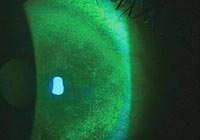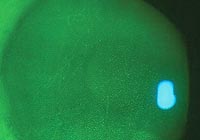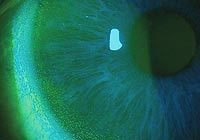Corneal staining can predict keratitis
Contact Lenses and Eyewear
When it comes to helping patients find the best contact lens/solution combination, many practitioners agree that staining grids, which have been developed to test how certain lenses and solutions work together, can clearly be a valuable and effective tool. But ask a clinician whether or not those same grids can predict infiltrative or infectious keratitis, and the waters become a little murkier.
“There is a wide array of types of corneal staining experienced in contact lens wearers,” Joseph P. Shovlin, OD, FAAO, told Primary Care Optometry News when asked if corneal staining indicated an increased risk of infection.
“Simply put, there is no peer reviewed scientific or clinical evidence to support that conjecture,” Dr. Shovlin said. “I find it unlikely that even high levels of solution-related staining that we see clinically on occasion can result in enough insult to breach the defense barriers of the cornea and allow for microorganisms to attach and invade. The equation is much more complex than that.”
William Townsend, OD, FAAO, agreed that the connection is complex, but said he thought staining could indicate increased risk of bacterial infection.
“We know that, for the most part, bacterial keratitis, with a few sterling exceptions, begins with the binding to the surface,” he told PCON in an interview. “Bacteria do not do that instantly. They have to have a foothold. We know that breaks in the cornea, even small breaks, serve as a point of entry.
“If you get enough [bacteria], and they are able to bind to the cornea and actually gain egress into the cornea,” he continued, “then you know you’ve got a problem.”
The risk of infiltrates
Two recent papers point to the link between corneal staining and infiltrates, according to Lyndon Jones PhD, FAAO, professor at the School of Optometry and associate director of the Centre for Contact Lens Research at the University of Waterloo.
“One was related to solution-based staining and another was related to staining in which there were no solutions involved at all,” Dr. Jones told PCON. “Both of those papers suggested an increased risk of developing small sterile peripheral infiltrates when there was a higher level of staining. Researchers were not able to show that it was directly associated with the staining, but those sterile peripheral infiltrates did occur at a higher level when there was more staining.
However, the problem, Dr. Jones concluded, is more complicated than it originally appears. Did the patients who developed the infiltrates do so because of a compromise to the epithelium induced by staining, or did they have another co-existing condition that caused the infiltrate?
| ||||||||
“It is kind of a chicken-and-egg situation,” Dr. Jones said. “For example, someone who may have lid disease may have a poor quality tear film. We know that blepharitis and meibomian gland dysfunction are associated with an increased level of gram-positive organisms and, therefore, they are more likely to show sterile infiltrates.
“Because those patients have a poor quality tear film, it could be that they are more likely to have corneal staining, but the sterile infiltrates were principally due to the presence of gram-positive exotoxins,” he continued. “I think that the jury is still out at the moment on the relationship between staining and infiltrates, but it certainly is something that people are watching carefully.”
Dr. Shovlin listed several predictive factors for corneal infiltrates with the use of contact lenses, including age, sex, higher refractive error and smoking.
 | ||
 | ||
 Photos from the Andrasko Staining Grid show excessive staining (top and middle) and very little staining (bottom). Images: Andrasko G | ||
“Even when solutions are not continuously employed (as in continuous wear), corneal staining and redness may predict the subsequent development of an infiltrative event,” he said. “So, I suppose it would be reasonable to expect that significant chronic corneal staining secondary to multipurpose solution use could be associated with a higher level of infiltrates.”
Infectious keratitis
Many practitioners strongly believe there is no link between corneal staining and infectious keratitis – Drs. Shovlin and Jones included.
“There is no evidence at this moment in time to support the idea that if there is an increase in corneal staining it will result in an increase in infections,” Dr. Jones stressed.
Dr. Townsend does believe there is a link, but he said it is more complex than just cause and effect.
“The amazing thing is that we see people with staining all the time and yet we see very few bacterial infections,” he said. “You have the right sort of mix. Otherwise, we’d see people with corneal ulcers all the time, and we don’t.”
Making the right choices
Dr. Townsend said some practitioners often can be unrealistic when it comes to staining. A little bit of corneal staining is commonly seen, he said.
“I would prefer all my patients not have staining,” he said. “But that’s not a reality. We have to do everything we can to minimize staining through making an appropriate choice of contact lens materials, solutions and patient education.”
Dr. Townsend said he stains his contact lens patients with flourescein once or twice a year.
Dr. Shovlin said staining grids do not have much impact on how he delivers care to his contact lens patients.
“It is important to remember that any grading system (or grid) should be used in conjunction with professional judgment and clinical experience,” he urged. “Unfortunately, there is no valid scientific evidence to suggest that the 2-hour staining results correlate well with anything that happens with wear throughout the day or beyond. A nonvalidated instrument such as a ‘staining grid’ is clearly misleading in terms of risk assessment and should not be relied upon as an absolute measure in lens type/solution selection.”
Dr. Jones said staining grids can be important for stressing to practitioners the vital role solutions play in contact lens success.
“Practitioners should start thinking about prescribing not only the lenses but the care system to go with it and driving across to the patient how important it is that they shouldn’t just be shopping around and arbitrarily switching solutions,” he said. “I think we have to get better at making sure practitioners routinely ask about what combinations patients use and that we routinely stain the cornea and look for corneal staining at every visit.”
For more information
- Joseph P. Shovlin, OD, FAAO, is a Primary Care Optometry News Editorial Board member who practices at Northeastern Eye Institute in Scranton, Pa. He can be reached at 200 Mifflin Ave., Scranton, PA 18503; (570) 342-3145; fax: (570) 344-1309; e-mail: jpshovlin@gmail.com.
- William Townsend, OD, practices at Advanced Eye Care in Canyon, Texas, and is an adjunct faculty member at the University of Houston College of Optometry. He can be reached at 1801 4th Ave., Canyon, TX 79015; (806) 655-7748; fax: (806) 655-2871; e-mail: drbill1@cox.net.
- Lyndon Jones, PhD, FAAO, is a professor at the School of Optometry and associate director of the Centre for Contact Lens Research, University of Waterloo, 200 University Avenue West, Waterloo, Ontario, Canada N2L 3G1; (519) 888-4742; fax: (519) 884-8769; email: lwjones@uwaterloo.ca.
References:
- Carnt N, et al. Solution toxicity in soft contact lens wear is associated with corneal inflammation. Optom Vis Sci. 2007;84(4):309-315.
- Szczotka-Flynn L, et al. Predictive factors for corneal infiltrates with continuous wear of silicone hydrogel contact lenses. Arch Ophthalmol. 2007;125(4):488-492.
